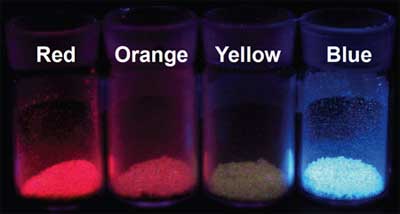| Posted: October 17, 2007 |
Development of fluorescent organic nanotubes |
|
(Nanowerk News) Researchers in the High-Axial-Ratio Nanostructure Fabrication Team at the Nanoarchitectonics Research Center of Japan's National Institute of Advanced Industrial Science and Technology (AIST) developed organic nanotubes that generate fluorescence (fluorescent ONT-AIST) by embedding fluorescent molecules in the membrane wall of organic nanotubes.
|
 |
| Emission of fluorescent ONT-AIST produced with rhodamine B (red), rhodamine 6G (orange), fluorescein (yellow), pyrene (blue). (Image: AIST)
|
|
The newly-developed fluorescent ONT-AIST is created by adding fluorescent molecules to amphiphilic molecules during self-assembly process of the nanotubes in solution. The fluorescent molecules are stably embedded in the wall of nanotubes. The tubular structure of the ONT-AIST remains hollow even after fluorescent molecules are added, and the fluorescent ONT-AIST still has the ability to include molecules such as drugs inside the hollow cylinder.
|
|
Standard fluorescent molecules were used to enable ONT-AIST to generate fluorescence. If a fluorescent molecule is added to amphiphilic molecules during the self-assembly process in an organic solution used in the ONT-AIST mass synthesis method developed by AIST, the fluorescent molecules are embedded in the nanotube wall to generate fluorescent ONT-AIST.
|
|
Source: AIST
|

